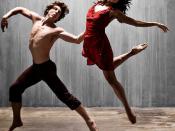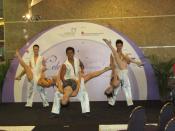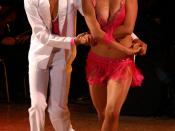Salsa is based on Cuban styles that had developed in the 30s, 40s and 50s. In the 60s and 70s the salsa spread to other parts of Latin America like Colombia and Venezuela. Through the 70s, "Metropolis" (in south-west Colombia) emerged as an important new center for salsa dance and music. In the late 70s "Metropolis" was labelled as "the world salsa capital". In the 80s, after salsa spread to other parts of Latin America, it was transfered to U.S.A It was accepted especially in L.A
Salsa is a sauce and there are two main ideas:
A. There are many ways salsa-sauce can be made. This has influenced the name of the dance because the Salsa dance is very different in each person who dances it.
B. One of the ways to make salsa-sauce is by using hot spices. Salsa dancing is very hot dance, and the hot music makes it very spicy.
Salsa - the dance and the idea
The salsa was a street dance before it developed and became more popular around the world. It was very social dance among the minorities in the Latin countries. It became very merchandise.
Now after it has going through the world the salsa has become a very close and intimate dance.
After awhile salsa caused some crowds of young males to come to the club just to meet women by showing them that they could dance. The women contributed to the situation and they selected with whom they would dance in the club.
So when you talked about salsa, people said: "You can meet girls in the club. Girls just love men that can dance salsa!".
Salsa style
Salsa is divided into two main groups: "The couple salsa" and "The group salsa".
"The couple salsa" has many different styles:
The CUBAN style:
The Cuban style was the first style of the salsa. This dance style is very close and intimate. Just a couple (that love/like each other) can dance this style. Some people call to this style: "The real salsa".
The Cuban style goes in circles (the couple moves together).
The basic steps:
Man's steps:
On count 1 you take the left leg one step forward.
On count 2 with the right leg you step in the place.
On count 3 you move the left leg to the starting point.
On count 4 with the right leg you do a Tab (touching the floor only with the toes).
On count 5 you take the right leg one step back.
On count 6 with the left leg you step in the place.
On count 7 you move the right leg to the starting point.
On count 8 with the left leg you do a Tab (touching the floor only with the toes).
Lady's steps:
On count 1 you take the right leg one step back.
On count 2 with the left leg you step in the place.
On count 3 you move the right leg to the starting point.
On count 4 with the left leg you do a Tab (touching the floor only with the toes).
On count 5 you take the left leg one step forward.
On count 6 with the right leg you step in the place.
On count 7 you move the left leg to the starting point.
On count 8 with the right leg you do a Tab (touching the floor only with the toes).
The COLOMBIAN style:
The Colombian style, which of the dancers calls: "the late style" because the Colombian style is developed after the Cuban salsa, so the Colombian salsa is more sophisticated than the Cuban style.
The Colombian style, like the Cuban style, goes in circles (the couple moves together).
There are some changes in the man's steps:
On count 8 instead of doing a Tub with the right leg you will do a cross over the left leg.
On count 4 instead of doing a Tub with the left leg you will do a cross over the right leg.
The NEW YORK style:
The N.Y style was influenced by the transfer of salsa from Latin America to the U.S.A. Because N.Y city is defined as "the first in everything" and "the city which has everything" the people in N.Y changed the salsa into something a little different and more extroverted.
The N.Y style, like the Cuban and Colombian style, goes in circles (the couple moves together).
The steps are the same as the "L.A style" (will be detailed in the "L.A style").
The L.A style:
The most popular style of all the salsa styles is the L.A style. This style character is to dance for the show. When you dance the L.A style you dance to show what you know or what you can do in the dance. The moves are very sharp and stylized, you add some lifts and stylized falls and more new things.
The L.A style, unlike the N.Y/Cuban/Colombian style that goes on circles, it goes on a straight line and when you turn you make 180 degrees.
There are some changes in the man's and lady's steps:
Count 4 and count 8 you do not count! You do not do anything with your foot on those counts.
The MIAMI style:
This style is called "the tied style" because of the steps and the moves used mainly with the hands and it is very complicated.
There is a little club in Tel-Aviv that teach Miami style"
The group salsa has just one style:
RUEDDA - CUBAN style:
This style is a little bit different to every other salsa style because the Ruedda is a circle of couples. Unlike the couple salsa, in which you can do whatever you want. Here you are told by one of the men (the leader of the Ruedda circle) what your next move will be.
In some way it is fun end beautiful to dance Ruedda because everybody is doing the same thing, together. But on the other hand, you cannot do what you want to do.
In Ruedda you do not standing face to face you are standing side by side. The man is from the right of the lady and the lady is from the left of the man.
Because that the Ruedda is a circle of couples so the idea is to pass always and that all the men will dance with all the ladies. How will you know when to pass? The leader of the circle will do a sign with the right hand that looks like "bring me something" or "come here". When he does that sign you will turn to your right and you take the other lady and dance with her according to leader of the circle.
The Ruedda's basic steps:
Man's steps:
On count 1 you take the left leg one step back.
On count 2 with the right leg you step in the place.
On count 3 you move the left leg to the starting point.
On count 4 with the right leg you do a Tab (touching the floor only with the toes).
On count 5 you take the right leg one step forward and with the entire body you do a ü turn to the left.
On count 6 with the left leg you step in the place.
On count 7 you move the right leg to the starting point.
On count 8 with the left leg you do a Tab (touching the floor only with the toes).
The lady's steps:
On count 1 you take the right leg one step back.
On count 2 with the left leg you step in the place.
On count 3 you move the right leg to the starting point.
On count 4 with the left leg you do a Tab (touching the floor only with the toes).
On count 5 you take the left leg one step forward and with the entire body you do a ü turn to the right.
On count 6 with the right leg you step in the place.
On count 7 you move the left leg to the starting point.
On count 8 with the right leg you do a Tab (touching the floor only with the toes).
The basic step of Ruedda calls "uapea".
Salsa today
The most popular style today in clubs is the L.A style. You can do whatever you like from all the styles. This is what is good about this style of salsa.
There are competitions around the world, congresses, festivals and special events.
In Israel, the salsa has received a very large push in the field of dance. The salsa has spread all over the world and now the high spot of the salsa awareness, in the world, is in Israel. For almost 2ý years, in Israel, salsa was the most popular style of all the dance styles. Salsa was not the leading dance in those years. Only in the dance sector, it was very popular in the area of music too. The Latin music is very sensual and the Israelis like romance, sexiness and hot music. This is why the Israelis were so connected to this type of music.
Salsa is very popular in Israel and all over the world. There is something in the salsa that draws you to dance it; is it the moves? Is it the music? Is it the dancers? Nobody knows what it is. It is just that.
Trainer's opinion
(Following the interview with my coach and trainer who taught me salsa)
"The salsa today is the most popular dance type in the area of dance. There are no many people that know about salsa. I think that we need to increase the awareness of the salsa history and sources. Most of the dancers that have been dancing for a few years now, don't know anything about salsa's sources except that it is a Latin dance or it was a street dance.
In the past, to dance salsa you needed to reveal your soul. Today, there are not many people that dance from their heart.
I hope that the awareness will spread more and more to dancers here and that other people will be more interested in salsa dancing and in the sources of salsa."
How did I started dancing salsa and became an instructor?
I am dancing salsa 4ý years and I am instructor for 2 years.
The first time when I bumped into salsa was is Spain, in a vacation, and I sue a couple dancing in a party, and then it strike me, the passion, the connection and the heart that I sue inside the dance. It was not like every other dance it was power-full and strong, and I felt the strength that they spread to all the people who was around them.
So I've checked, while I was in Spain, were I could learn how to dance salsa and every day for 3ý weeks, in my vacation, I went to a studio of salsa and I took lessons until I learned perfectly how to dance.
When I came back to Israel I went every Tuesday and Wednesday to learn and dance salsa.
One Saturday night while I was dancing D.J Hilel came to me and he tolled me that he was watching me dancing few times and he asked me if I want to be a teacher in his club?, and I said yes.
Since then we are friends and an A-team in salsa and in the real life.
Most of my salsa years he was guide me.


